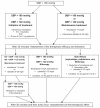Pre-eclampsia: pathophysiology, diagnosis, and management
- PMID: 21822394
- PMCID: PMC3148420
- DOI: 10.2147/VHRM.S20181
Pre-eclampsia: pathophysiology, diagnosis, and management
Abstract
The incidence of pre-eclampsia ranges from 3% to 7% for nulliparas and 1% to 3% for multiparas. Pre-eclampsia is a major cause of maternal mortality and morbidity, preterm birth, perinatal death, and intrauterine growth restriction. Unfortunately, the pathophysiology of this multisystem disorder, characterized by abnormal vascular response to placentation, is still unclear. Despite great polymorphism of the disease, the criteria for pre-eclampsia have not changed over the past decade (systolic blood pressure > 140 mmHg or diastolic blood pressure ≥ 90 mmHg and 24-hour proteinuria ≥ 0.3 g). Clinical features and laboratory abnormalities define and determine the severity of pre-eclampsia. Delivery is the only curative treatment for pre-eclampsia. Multidisciplinary management, involving an obstetrician, anesthetist, and pediatrician, is carried out with consideration of the maternal risks due to continued pregnancy and the fetal risks associated with induced preterm delivery. Screening women at high risk and preventing recurrences are key issues in the management of pre-eclampsia.
Keywords: epidemiology; pathophysiology; pre-eclampsia; therapeutic management.
Figures
References
-
- Sibai B, Dekker G, Kupferminc M. Pre-eclampsia. Lancet. 2005;365:785–799. - PubMed
-
- Pottecher T, Luton D. Prise en Charge Multidisciplinaire de la Prééclampsie. French. Issy Les Moulineaux, France: Elsevier; Masson SAS; 2009.
-
- Carty DM, Delles C, Dominiczak AF. Preeclampsia and future maternal health. J Hypertens. 2010;28:1349–1355. - PubMed
-
- Duley L. The global impact of pre-eclampsia and eclampsia. Semin Perinatol. 2009;33:130–137. - PubMed
-
- Zhang J, Zeisler J, Hatch MC, Berkowitz G. Epidemiology of pregnancy- induced hypertension. Epidemiol Rev. 1997;19:218–232. - PubMed
Publication types
MeSH terms
LinkOut - more resources
Full Text Sources
Miscellaneous


